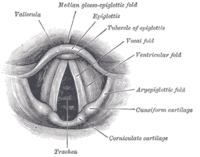
Photo from wikipedia
OBJECTIVE To determine the cardiometabolic demands associated with exoskeletal-assisted walking (EAW) in persons with paraplegia. This study will further examine if training in the device for sixty sessions modifies cost… Click to show full abstract
OBJECTIVE To determine the cardiometabolic demands associated with exoskeletal-assisted walking (EAW) in persons with paraplegia. This study will further examine if training in the device for sixty sessions modifies cost of transport (CT). DESIGN Prospective cohort study. Measurements over the course of a sixty-session training program, approximately twenty sessions apart. SETTING James J. Peters Bronx Veterans Affairs Medical Center, Center for the Medical Consequences of Spinal Cord Injury Research Center. PARTICIPANTS The five participant's demographics were: 37-61 years old, 22.7-28.6 BMI (kg/m2), level of injury ranged from T1-T11, and were 2-14 years since injury. INTERVENTIONS Powered EAW. MAIN OUTCOME MEASURES Oxygen Consumption (VO2, ml/min/kg), Velocity (m/min), Cost of Transport (VO2/Velocity), Rating of perceived exertion (RPE). RESULTS With training: EAW velocity significantly improved (Pre: 51±51m; 0.14±0.14m/s vs. Post: 99±42m; 0.28±0.12m/s, p=0.023), RPE significantly decreased (Pre: 13±6 vs. Post: 7±4, p=0.001), VO2 significantly improved (Pre: 9.76±1.23 ml/kg/m vs. Post: 12.73±2.30 ml/kg/m, p=0.04), and CT was reduced from the early to the later stages of training (3.66±5.2 vs. 0.87±0.85 ml/kg/m). CONCLUSIONS The current study suggests that EAW training improves oxygen uptake efficiency and walking velocities, with a lower perception of exertion.
Journal Title: Archives of physical medicine and rehabilitation
Year Published: 2020
Link to full text (if available)
Share on Social Media: Sign Up to like & get
recommendations!